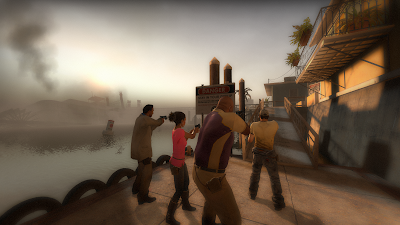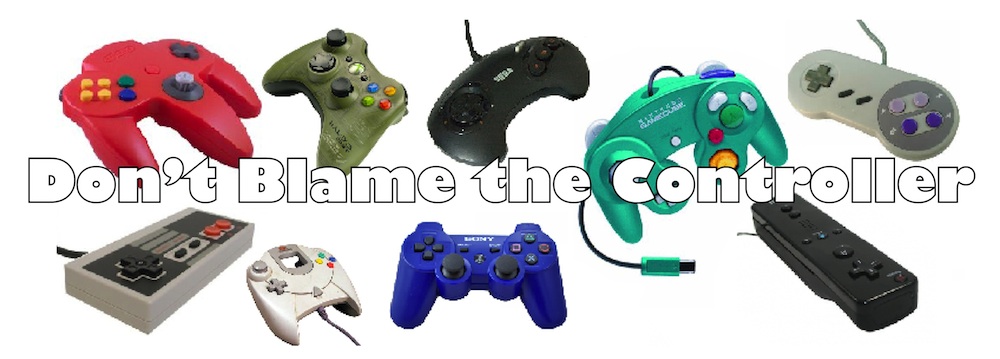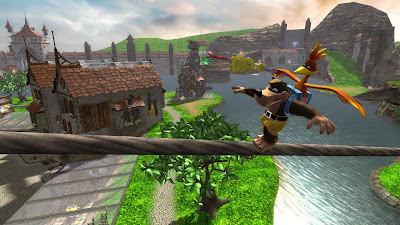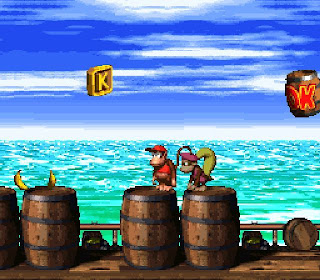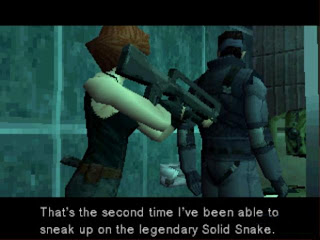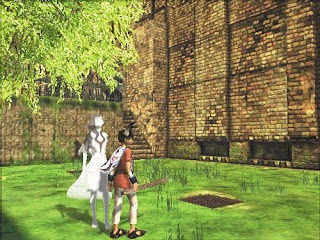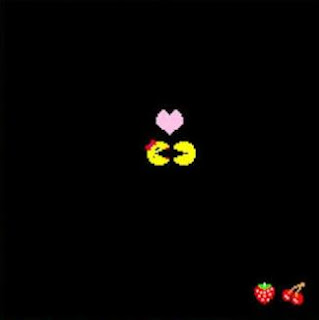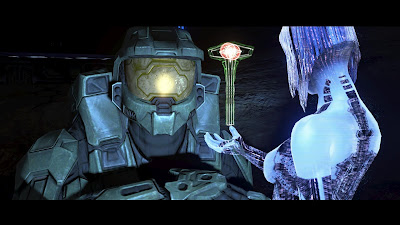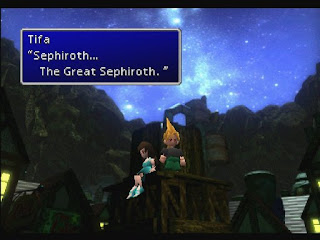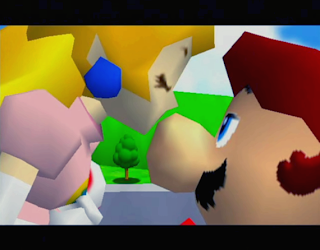Editor's Note: for those of you who don't know,
Left 4 Dead and its sequel
Left 4 Dead 2 are best played with friends. Below is an interview conducted with four friends who survived the zombie apocalypse together...twice!
 |
| The gang. |
1) How does Left 4 Dead 2
compare to the original Left 4 Dead
?
 Evan (Coach):
Evan (Coach): It's noticeably better. The original
Left 4 Dead was a blast to play with friends, but there was only so much you could do.
Left 4 Dead 2 adds a fifth campaign, a new fast-paced multiplayer mode called "Scavenge," and, most importantly, diversity within the campaigns. In
Left 4 Dead, the campaigns were set in different locales, but featured largely the same structure: run from safehouse to safehouse, avoiding zombies, and then defend a stronghold until help arrived. In
Left 4 Dead 2, however, survivors are asked to fetch items, move forward and
backward through levels, and, in one case, run for their lives across a bridge to safety instead of hunkering down and waiting for help.
 Kevin (Rochelle): L4D2
Kevin (Rochelle): L4D2 feels like the plucky comic relief friend who attends your family dinner every night. With that respect, I feel it’s more of a spin-off than a sequel – still, the additions are fantastic. I certainly enjoy the melee weapons as opposed to the previous elbow or a push in the first game. They did keep the original melee attack in the game for those who have fine-tuned their coordinated zombie kills. As for the additional health items (adrenaline shot and defibrillator) I rarely use them. The only time I would pick up a shot would be if I knew the level called for it. First time players would not have a heads up of where they would need an increase of speed. The characters do a better job identifying items and giving hints where to go in the level, yet Ellis tends to chatter if you stay put. The additional special infected and the new uncommon infected zombies are a great challenge. This is definitely a harder game than the first.
 Nick (Nick): Left 4 Dead 2
Nick (Nick): Left 4 Dead 2 is an improvement over the original. The overall feel is still the same but the second game is more complex. It’s nice how the different chapters actually feel like a complete story. The first game did not seem to flow as well. It’s also nice to have some objective built in, such as getting gas for the car or running across the bridge. The new scavenge mode is a nice touch and I particularly like the 4 on 4 versus.
 Rob (Ellis): Left 4 Dead 2
Rob (Ellis): Left 4 Dead 2 is impressive in the way that it takes all that is good about the first
Left 4 Dead and actually improves upon it. To be frank a four person cooperative game can be a bit unruly, especially if you’re not playing with actual friends but associates you meet on Xbox Live. The original game rewarded cooperation and its focused gameplay (running from safe room to safe room) forced the team to act as a unit, for the most part. The original
Left 4 Dead however could be repetitive. Each campaign followed the same outline: four chapters of progress to a new safe room followed by a final chapter of mainly defense until help would arrive.
Left 4 Dead 2 tweaks the formula enough that while it’s still familiar, it’s different enough to avoid feeling like the exact same game. There are more weapons, greater enemy types, and the game itself it more challenging. For one example, no longer are you attacked by just one special infected at a given time. There are times when it’s almost a coordinated effort on behalf of the mindless zombies to disrupt the team and prevent survivors from being saved. The final chapters are also all different enough that they’re all worth playing more than once as opposed to the original game where each finale pretty much was the same.
2) What is your favorite new projectile/melee weapon?
Evan: The combat rifle, hands down. I'm a huge fan of accuracy over firepower when it comes to video game weapons, and the combat rifle delivers the best accuracy of any assault rifle in the game. With a laser sight attached, it's even more accurate. It has a slow reload time, but with it I can pick off special infected from a distance.
 Kevin:
Kevin: Hard to say. It has changed many times. It was the chainsaw first, and then the katana, and more recently the cricket bat. Something about the sound and the zombies head exploding. I also started the game reaching for my original standby, a Molotov cocktail. Now I go for the Boomer bile. It renders the Tank somewhat blind as normal infected zombies do all the work for you. This gives you a chance to reload, heal, or get to a more opportunistic location.
Nick: My favorite new weapon would have to be the chainsaw. I mean how did it take so long to add a chainsaw to a zombie game? How can you have a zombie apocalypse without a chainsaw? It’s also fun to get yourself surrounded by zombies and pull the 360° chainsaw spin.
 Rob:
Rob: The combat rifle, especially outfitted with laser sight was always my go-to weapon of choice. I prefer a hail of bullets, especially when dealing with a horde, to a shotgun where you’re only popping off one round at a time. It’s not always the best weapon of choice, but the damage it inflicts allows easier cleanup of infected even if you spray your teammates a little. For melee weapon, the katana beats out the rest. I suppose you could be lazy and let the chainsaw do all the work however you get enormous satisfaction out of slicing and dicing your way through a horde. Unleash your inner Bride and go to town on any zombies that are foolish enough to enter your sphere of destruction. One of my proudest moments was slashing three zombies across the chest at the same time and watching them fly backwards. It just looked so cool.
 |
| A Spitter. Brrrr, is she ugly! |
3) Least favorite new special infected?
Evan: This is easy. It's the Jockey. This special infected runs low along the ground, then hops onto a survivor and "rides" him or her around, often into other hazards. He's also a pain to dislodge from a teammate. He's a small, moving target attached to a friend's head – not an easy thing to shoot off.
Kevin: Spitter. You will be minding your own business when all of a sudden you find yourself surrounded by acid. You try to find a way out of the goo as quickly as possible but it can incapacitate you fast. I will admit that it is difficult to kill a moving Jockey. If you fall behind, a Jockey will pull you farther away from the group. A Jockey is my least favorite when playing in realism mode. In this mode, you cannot see your teammates’ outline through walls and buildings. If you are incapacitated by a special infected and you are away from the group, be prepared to lose a bit of health before you are found.
Nick: My least favorite special infection would be the Spitter. The Spitter is very annoying, the way it corners you and gets that green stuff all over the place. It takes so much life away so quickly. It can be really hard to get out of the spit puddle and there is nothing your teammates can do it to protect you from it. At least when you get jockeyed or charged someone can shoot them off.
Rob: This question could be taken in two different ways: what’s your least favorite infected to come across or what’s your least favorite infected to play as in Versus mode. For both answers, it’s the Spitter. Not only is she ugly (and that’s saying something in a zombie apocalypse) there’s no way to tell exactly where that acid spit is going to fall. It just slowly spreads out once a small patch has landed on the ground. Playing as the Spitter is just as bad for the same reason. Try as you might you can never tell where your spit is going to land. I probably overshoot 75% of the time when I play as a Spitter. It’s awful.
 |
| The bridge to nowhere. |
4) Favorite part of the game?
Evan: There's a lot to love in
Left 4 Dead 2, but the part of the game that stands out in my mind is the fifth and final campaign, "The Parish," specifically its final chapter. It's a mad dash across a crumbling bridge piled high with abandoned cars and hundreds of infected zombies. At the far end is a military helicopter waiting to fly the survivors to safety. It's easily the most fun I've ever had in a
Left 4 Dead game.
Kevin: Again, it is hard to say. Every level is made very well. I have found it fun to play the bridge in the finale of “The Parish” campaign. In the level, there is no place to go but forward. Occasionally you would find a truck or spot to recover or reload, but the stampede behind you will not let you stop for long. The “Dark Carnival” campaign looked very well made, complete with bumper cars, tunnel of love, roller coasters, whack-a-mole, shooting alley, strong man game, and clowns. I only wish I could ride a Ferris wheel and snipe out the infected ahead of the level.
Nick: My favorite part of the game is the bridge at the end of “The Parish.” It’s a nice change of pace for a final chapter to have an objective to move towards rather than just have to hunker down and fight. It is also nice that it forces everyone else to move fast, which is my strategy all the time.
Rob: Not to be repetitive, but I absolutely love the bridge run in “The Parish”. You really get the adrenaline feel of being in a zombie apocalypse, shooting and hacking your way through wave after wave of infected. Any kind of mad dash at the finish is always exciting and
Left 4 Dead 2 caps off its final campaign with the players truly wanting more. Pop that adrenaline shot and just keep moving.
 |
| Back to back! |
5) Which friend would you most want in a real zombie apocalypse, and why?
Evan: Have to go with Rob on this one. First, he and I tend to have the most similar playing style in the
Left 4 Dead games. We stay in the middle of the group, we favor balanced weapons, and we have a good sense of space, something that is vitally important in these games. Plus, Rob tends to be more altruistic in
Left 4 Dead 2, which nicely balances my sometimes selfish behavior. Also, his knowledge of
The Walking Dead would no doubt come in handy.
Kevin: In a real zombie apocalypse I would want Nick. He is more likely to have fired an actual firearm. If real life had the rules of
L4D2 I would want Rob. He is a good balance of accuracy and he'd come back for me if I were down.
Nick: I would choose myself; everyone else moves too slowly. Who wants to screw around and go slow during the zombie apocalypse? It only serves to let the zombie hoards catch up to you. Also, taking out a zombie’s brain can’t be that different from taking out a tooth.
Rob: Well it’s pretty obvious I’d have to go with Evan. Our strategies are so in sync that cooperation is always guaranteed. In a zombie apocalypse you can’t waste valuable time debating, or worse arguing, on the best route to take. It always seems we both end up going the same route without the need for discussion. Plus, since Evan and I share a brain, if I didn’t pick him, I’d be handicapping myself from the start. However if I were tempted to use a sacrifice as a diversion, I’d go with Nick since he readily offers himself up to the infected.
6) How much is your character like you, if at all?
Evan: I played as Coach, a retired football player with a sweet tooth. See any red flags? Although I don't have his physical strength or predilection for chocolate, I like Coach a lot. He's a natural leader with a no-nonsense attitude. He's a survivor. I'm glad I chose him.
Kevin: I'm nothing like my character. I didn't want to choose the girl in the first place. You guys are jerks! I’m going home!
Nick: Obviously my character is just like me. Besides sharing the same name, we are both well-dressed professional gamblers. He and I share the same biting sarcasm.
Rob: I guess you could say I’m a little like Ellis. While Ellis likes to rattle on about God knows what (you’re not in a safe room if Ellis isn’t spinning a yarn no one cares about), I also like to chat whilst fighting for survival. Apparently he’s also an expert in his field (cars need gas to go!) like I am in mine with my expert-level photocopying.
 |
| Will that be cash or charge? |
7) Favorite memory of the game?
Evan: My favorite moment of the game came in a four-on-four versus match. It was the first chapter of the first campaign, and Kevin, Nick, Rob, and I were playing the infected. We were hunting a team of players navigating their way through a burning hotel. At one point in the map, the survivors are forced to walk outside on the ledge of the hotel. I was playing as the charger, a bulky special infected whose special attack is to (surprise!) charge at the survivors. I hid in an empty hotel room waiting for one of the survivors to walk along the ledge past an open window. As soon as Coach walked in front of the window, I lowered my shoulder and charged. We both went flying off the ledge and onto the street below. We both died, but as a special infected I was able to respawn. It was a beautiful thing.
Kevin: Probably getting grabbed by a charger right before I entered the safe house. The others tell the story better than I do. Moments like that usually don’t happen again. I’ve since forgiven the charger…with my chainsaw!
Nick: My favorite memory is definitely when we were all running for the safe room and Rob, Evan, and I all made it to the room. Kevin was badly injured and was very slowly hobbling to the room. He kept saying, “I’m good, I’m good, I’m good.” Then out of nowhere a charger grabs Kevin and repeatedly slams him against the ground. All we could do was watch as Kevin met his untimely demise.
Rob: Kevin (Rochelle) getting pounded by the Charger while the rest of us are secure in the safe room is classic
Left 4 Dead for our group, however I’m going to go with Nick and I versus Evan in a scavenge match. With three bots on his side, you would thing Nick and I wouldn’t stand a chance even getting close to him, however
Left 4 Dead 2 apparently made the bots stupider and I was able to take Evan for a “qualified ride” as a jockey. Not only is the jockey riding someone (else) hilarious, but just directing Evan further and further away from his group while the bots just stood around and shrugged their shoulders was truly a fun moment.
8) What score would you give Left 4 Dead 2?
Evan: Left 4 Dead 2 gets a 9/10. It's a blast to play with three friends, cooperatively or competitively. The campaigns are memorable and varied, the versus modes are frantic and often hilarious, and the addition of melee weapons makes the whole experience insanely fun. It's a bigger, better, and more complete game than its predecessor.
Kevin: I would give the game 8.5/10. The game is a clear improvement to the first one, but I feel like they could have been one game. If they truly were one title, then it would make more sense to gain more fighting experience, abilities weapons, and items, i.e., melee weapons, health items, more special infected.
L4D2 almost seems like it could have been an add-on or downloadable content. I guess Valve cares about putting out the titles in a timely fashion, rather than waiting until they have another epic like the
Half-Life franchise. I’ve yet to play
Portal 2. I hope it hasn’t fallen victim to the same fate as
L4D2.
Nick: I would give it an 8.5/10 because while I really enjoyed the game, and it has great replay value, it still doesn't feel like a complete game to me.
Rob: As I stated earlier,
Left 4 Dead 2 improves upon the original while still providing a good time with your friends on Xbox Live. For that, I will give
Left 4 Dead 2 a 9/10. It’s not a perfect game, but it is one you can keep going back to again and again and experience something new each time.
